Chronic Heart Failure Question and Answer 2022
VerifiedAdded on 2022/09/28
|10
|2569
|22
AI Summary
Contribute Materials
Your contribution can guide someone’s learning journey. Share your
documents today.
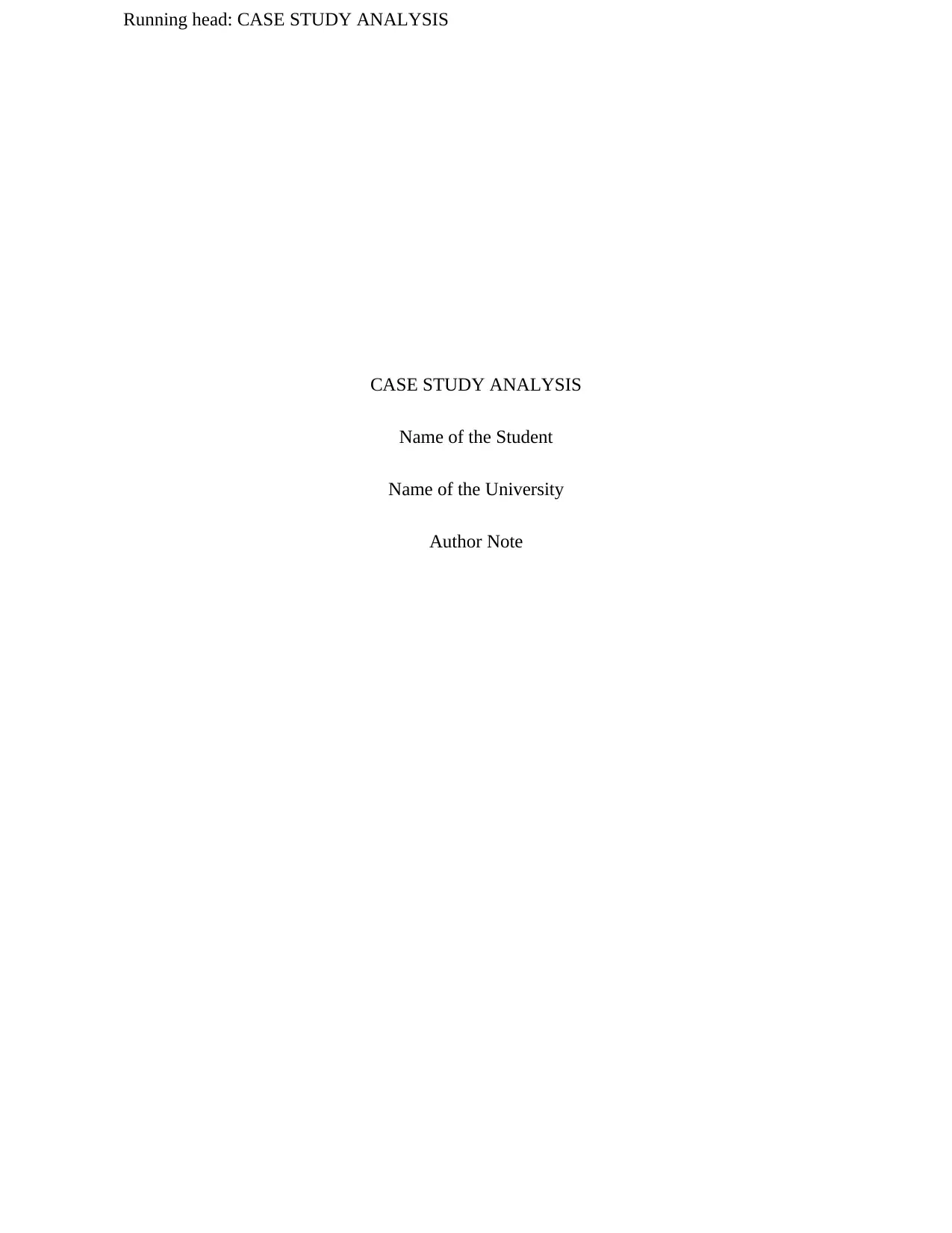
Running head: CASE STUDY ANALYSIS
CASE STUDY ANALYSIS
Name of the Student
Name of the University
Author Note
CASE STUDY ANALYSIS
Name of the Student
Name of the University
Author Note
Secure Best Marks with AI Grader
Need help grading? Try our AI Grader for instant feedback on your assignments.
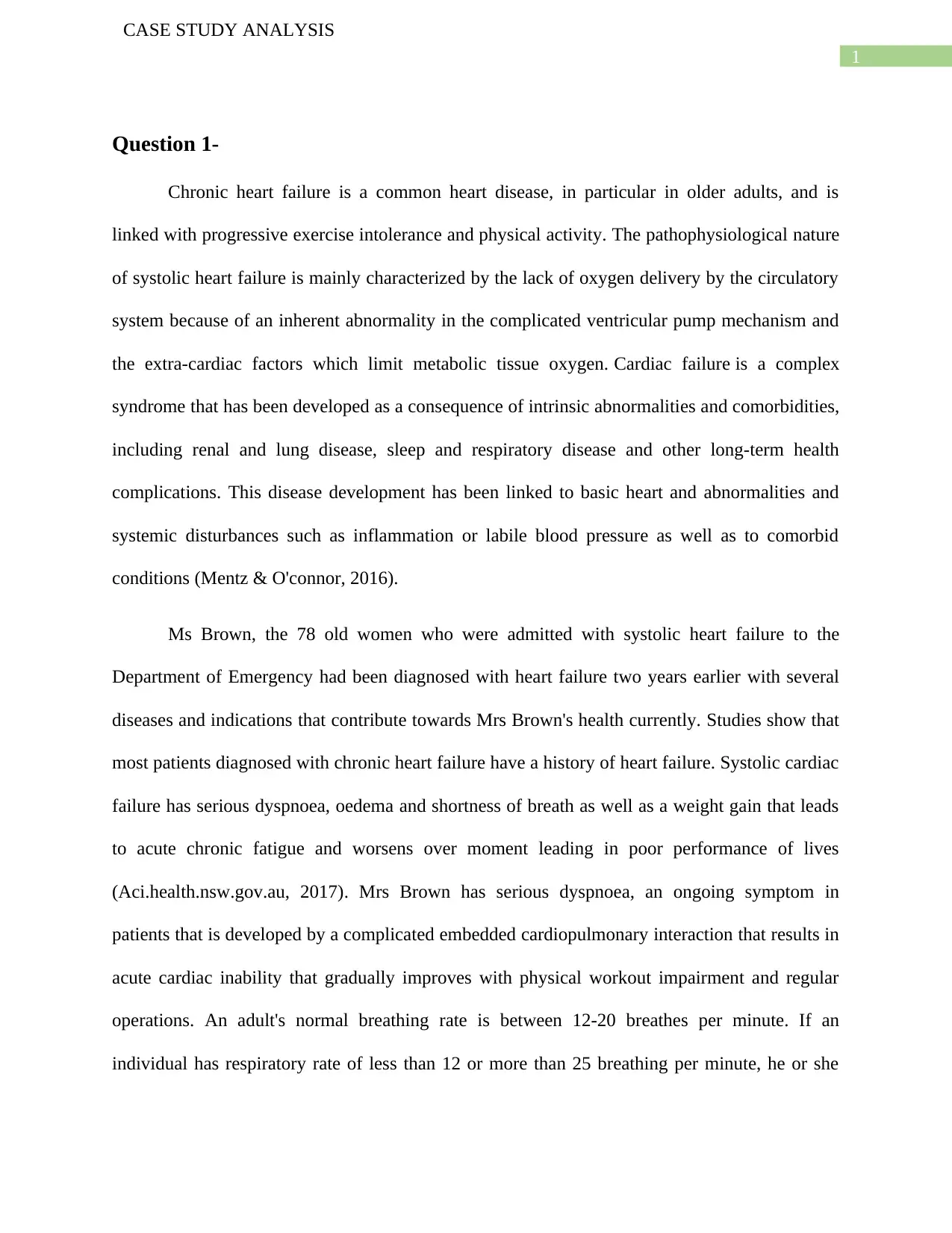
1
CASE STUDY ANALYSIS
Question 1-
Chronic heart failure is a common heart disease, in particular in older adults, and is
linked with progressive exercise intolerance and physical activity. The pathophysiological nature
of systolic heart failure is mainly characterized by the lack of oxygen delivery by the circulatory
system because of an inherent abnormality in the complicated ventricular pump mechanism and
the extra-cardiac factors which limit metabolic tissue oxygen. Cardiac failure is a complex
syndrome that has been developed as a consequence of intrinsic abnormalities and comorbidities,
including renal and lung disease, sleep and respiratory disease and other long-term health
complications. This disease development has been linked to basic heart and abnormalities and
systemic disturbances such as inflammation or labile blood pressure as well as to comorbid
conditions (Mentz & O'connor, 2016).
Ms Brown, the 78 old women who were admitted with systolic heart failure to the
Department of Emergency had been diagnosed with heart failure two years earlier with several
diseases and indications that contribute towards Mrs Brown's health currently. Studies show that
most patients diagnosed with chronic heart failure have a history of heart failure. Systolic cardiac
failure has serious dyspnoea, oedema and shortness of breath as well as a weight gain that leads
to acute chronic fatigue and worsens over moment leading in poor performance of lives
(Aci.health.nsw.gov.au, 2017). Mrs Brown has serious dyspnoea, an ongoing symptom in
patients that is developed by a complicated embedded cardiopulmonary interaction that results in
acute cardiac inability that gradually improves with physical workout impairment and regular
operations. An adult's normal breathing rate is between 12-20 breathes per minute. If an
individual has respiratory rate of less than 12 or more than 25 breathing per minute, he or she
CASE STUDY ANALYSIS
Question 1-
Chronic heart failure is a common heart disease, in particular in older adults, and is
linked with progressive exercise intolerance and physical activity. The pathophysiological nature
of systolic heart failure is mainly characterized by the lack of oxygen delivery by the circulatory
system because of an inherent abnormality in the complicated ventricular pump mechanism and
the extra-cardiac factors which limit metabolic tissue oxygen. Cardiac failure is a complex
syndrome that has been developed as a consequence of intrinsic abnormalities and comorbidities,
including renal and lung disease, sleep and respiratory disease and other long-term health
complications. This disease development has been linked to basic heart and abnormalities and
systemic disturbances such as inflammation or labile blood pressure as well as to comorbid
conditions (Mentz & O'connor, 2016).
Ms Brown, the 78 old women who were admitted with systolic heart failure to the
Department of Emergency had been diagnosed with heart failure two years earlier with several
diseases and indications that contribute towards Mrs Brown's health currently. Studies show that
most patients diagnosed with chronic heart failure have a history of heart failure. Systolic cardiac
failure has serious dyspnoea, oedema and shortness of breath as well as a weight gain that leads
to acute chronic fatigue and worsens over moment leading in poor performance of lives
(Aci.health.nsw.gov.au, 2017). Mrs Brown has serious dyspnoea, an ongoing symptom in
patients that is developed by a complicated embedded cardiopulmonary interaction that results in
acute cardiac inability that gradually improves with physical workout impairment and regular
operations. An adult's normal breathing rate is between 12-20 breathes per minute. If an
individual has respiratory rate of less than 12 or more than 25 breathing per minute, he or she
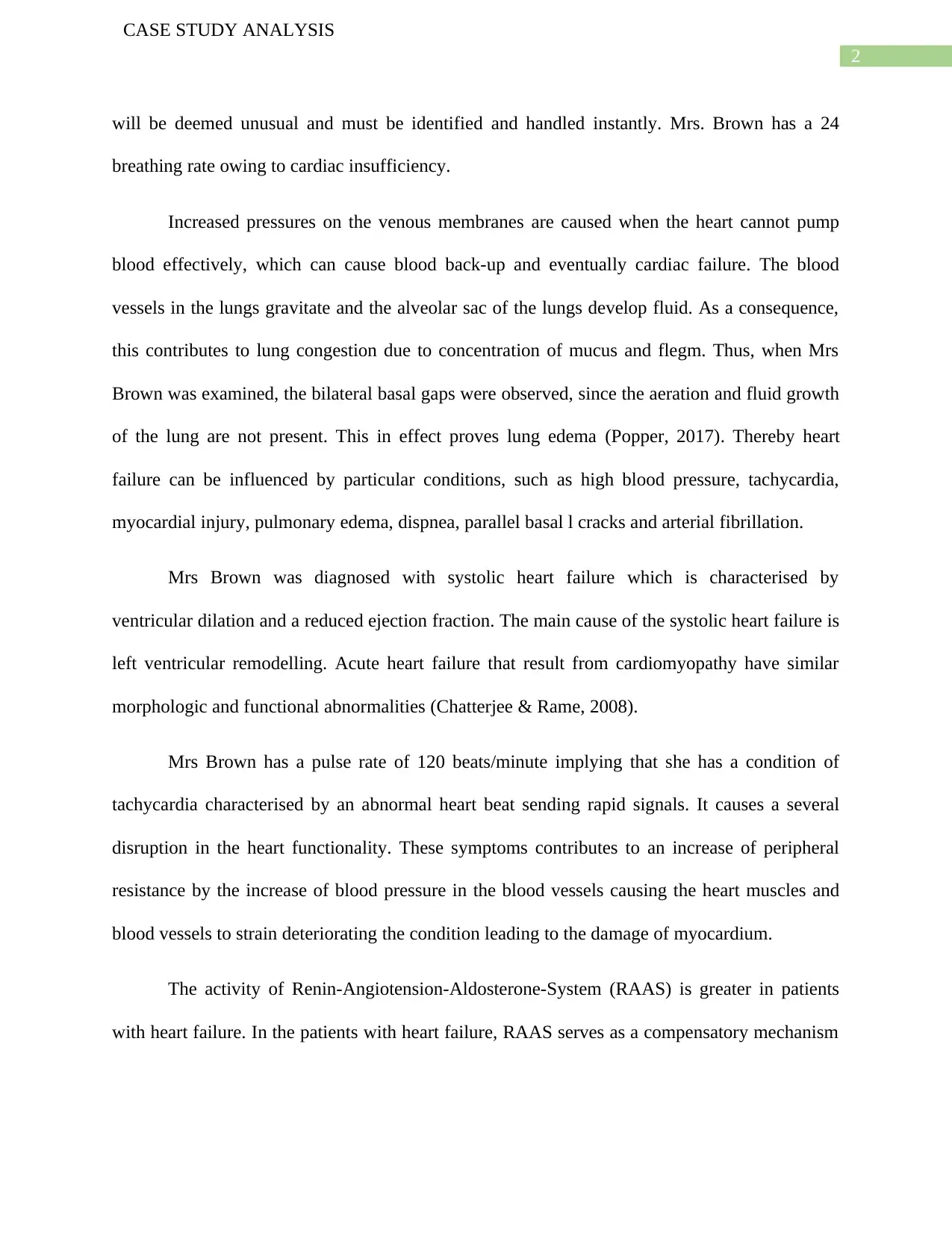
2
CASE STUDY ANALYSIS
will be deemed unusual and must be identified and handled instantly. Mrs. Brown has a 24
breathing rate owing to cardiac insufficiency.
Increased pressures on the venous membranes are caused when the heart cannot pump
blood effectively, which can cause blood back-up and eventually cardiac failure. The blood
vessels in the lungs gravitate and the alveolar sac of the lungs develop fluid. As a consequence,
this contributes to lung congestion due to concentration of mucus and flegm. Thus, when Mrs
Brown was examined, the bilateral basal gaps were observed, since the aeration and fluid growth
of the lung are not present. This in effect proves lung edema (Popper, 2017). Thereby heart
failure can be influenced by particular conditions, such as high blood pressure, tachycardia,
myocardial injury, pulmonary edema, dispnea, parallel basal l cracks and arterial fibrillation.
Mrs Brown was diagnosed with systolic heart failure which is characterised by
ventricular dilation and a reduced ejection fraction. The main cause of the systolic heart failure is
left ventricular remodelling. Acute heart failure that result from cardiomyopathy have similar
morphologic and functional abnormalities (Chatterjee & Rame, 2008).
Mrs Brown has a pulse rate of 120 beats/minute implying that she has a condition of
tachycardia characterised by an abnormal heart beat sending rapid signals. It causes a several
disruption in the heart functionality. These symptoms contributes to an increase of peripheral
resistance by the increase of blood pressure in the blood vessels causing the heart muscles and
blood vessels to strain deteriorating the condition leading to the damage of myocardium.
The activity of Renin-Angiotension-Aldosterone-System (RAAS) is greater in patients
with heart failure. In the patients with heart failure, RAAS serves as a compensatory mechanism
CASE STUDY ANALYSIS
will be deemed unusual and must be identified and handled instantly. Mrs. Brown has a 24
breathing rate owing to cardiac insufficiency.
Increased pressures on the venous membranes are caused when the heart cannot pump
blood effectively, which can cause blood back-up and eventually cardiac failure. The blood
vessels in the lungs gravitate and the alveolar sac of the lungs develop fluid. As a consequence,
this contributes to lung congestion due to concentration of mucus and flegm. Thus, when Mrs
Brown was examined, the bilateral basal gaps were observed, since the aeration and fluid growth
of the lung are not present. This in effect proves lung edema (Popper, 2017). Thereby heart
failure can be influenced by particular conditions, such as high blood pressure, tachycardia,
myocardial injury, pulmonary edema, dispnea, parallel basal l cracks and arterial fibrillation.
Mrs Brown was diagnosed with systolic heart failure which is characterised by
ventricular dilation and a reduced ejection fraction. The main cause of the systolic heart failure is
left ventricular remodelling. Acute heart failure that result from cardiomyopathy have similar
morphologic and functional abnormalities (Chatterjee & Rame, 2008).
Mrs Brown has a pulse rate of 120 beats/minute implying that she has a condition of
tachycardia characterised by an abnormal heart beat sending rapid signals. It causes a several
disruption in the heart functionality. These symptoms contributes to an increase of peripheral
resistance by the increase of blood pressure in the blood vessels causing the heart muscles and
blood vessels to strain deteriorating the condition leading to the damage of myocardium.
The activity of Renin-Angiotension-Aldosterone-System (RAAS) is greater in patients
with heart failure. In the patients with heart failure, RAAS serves as a compensatory mechanism
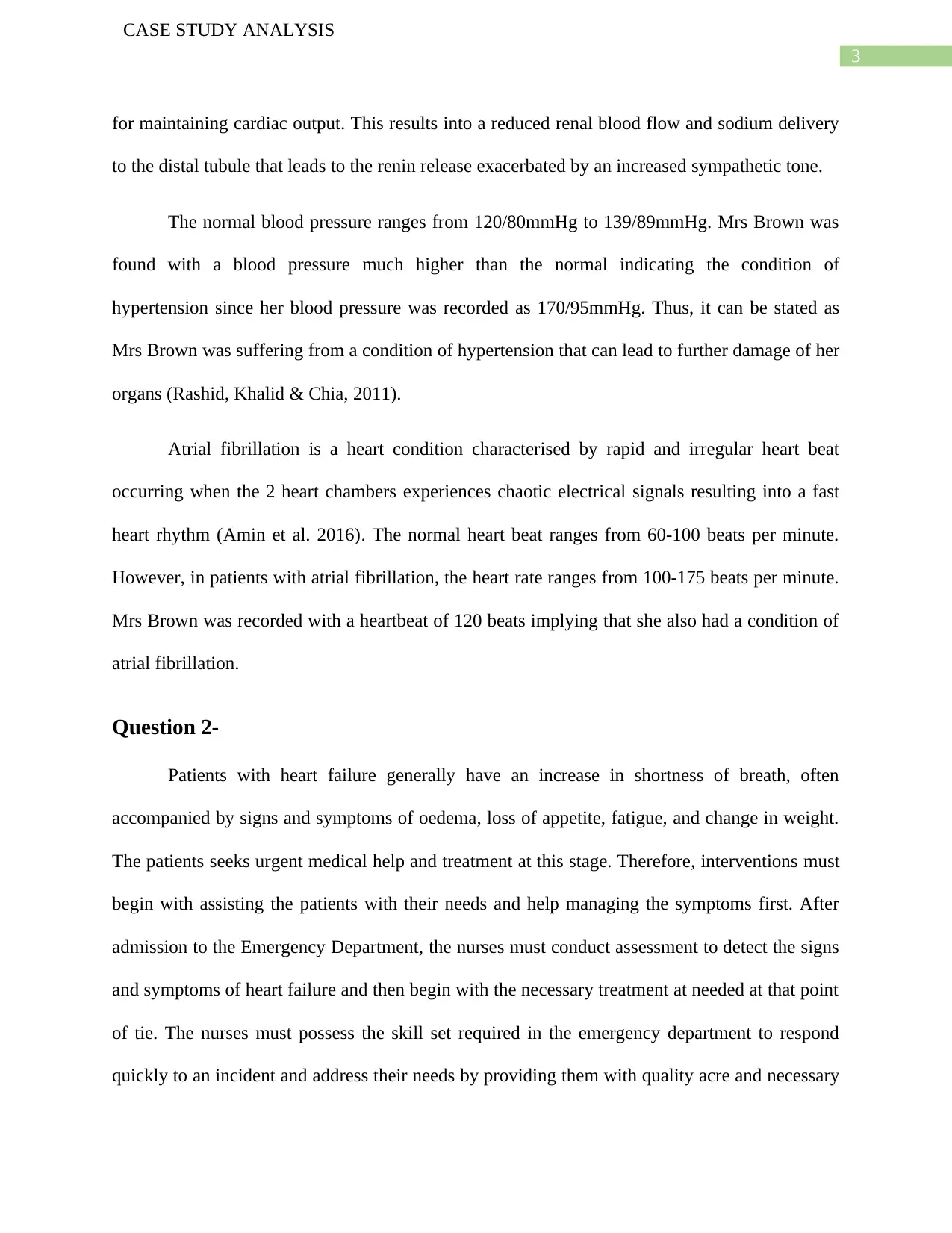
3
CASE STUDY ANALYSIS
for maintaining cardiac output. This results into a reduced renal blood flow and sodium delivery
to the distal tubule that leads to the renin release exacerbated by an increased sympathetic tone.
The normal blood pressure ranges from 120/80mmHg to 139/89mmHg. Mrs Brown was
found with a blood pressure much higher than the normal indicating the condition of
hypertension since her blood pressure was recorded as 170/95mmHg. Thus, it can be stated as
Mrs Brown was suffering from a condition of hypertension that can lead to further damage of her
organs (Rashid, Khalid & Chia, 2011).
Atrial fibrillation is a heart condition characterised by rapid and irregular heart beat
occurring when the 2 heart chambers experiences chaotic electrical signals resulting into a fast
heart rhythm (Amin et al. 2016). The normal heart beat ranges from 60-100 beats per minute.
However, in patients with atrial fibrillation, the heart rate ranges from 100-175 beats per minute.
Mrs Brown was recorded with a heartbeat of 120 beats implying that she also had a condition of
atrial fibrillation.
Question 2-
Patients with heart failure generally have an increase in shortness of breath, often
accompanied by signs and symptoms of oedema, loss of appetite, fatigue, and change in weight.
The patients seeks urgent medical help and treatment at this stage. Therefore, interventions must
begin with assisting the patients with their needs and help managing the symptoms first. After
admission to the Emergency Department, the nurses must conduct assessment to detect the signs
and symptoms of heart failure and then begin with the necessary treatment at needed at that point
of tie. The nurses must possess the skill set required in the emergency department to respond
quickly to an incident and address their needs by providing them with quality acre and necessary
CASE STUDY ANALYSIS
for maintaining cardiac output. This results into a reduced renal blood flow and sodium delivery
to the distal tubule that leads to the renin release exacerbated by an increased sympathetic tone.
The normal blood pressure ranges from 120/80mmHg to 139/89mmHg. Mrs Brown was
found with a blood pressure much higher than the normal indicating the condition of
hypertension since her blood pressure was recorded as 170/95mmHg. Thus, it can be stated as
Mrs Brown was suffering from a condition of hypertension that can lead to further damage of her
organs (Rashid, Khalid & Chia, 2011).
Atrial fibrillation is a heart condition characterised by rapid and irregular heart beat
occurring when the 2 heart chambers experiences chaotic electrical signals resulting into a fast
heart rhythm (Amin et al. 2016). The normal heart beat ranges from 60-100 beats per minute.
However, in patients with atrial fibrillation, the heart rate ranges from 100-175 beats per minute.
Mrs Brown was recorded with a heartbeat of 120 beats implying that she also had a condition of
atrial fibrillation.
Question 2-
Patients with heart failure generally have an increase in shortness of breath, often
accompanied by signs and symptoms of oedema, loss of appetite, fatigue, and change in weight.
The patients seeks urgent medical help and treatment at this stage. Therefore, interventions must
begin with assisting the patients with their needs and help managing the symptoms first. After
admission to the Emergency Department, the nurses must conduct assessment to detect the signs
and symptoms of heart failure and then begin with the necessary treatment at needed at that point
of tie. The nurses must possess the skill set required in the emergency department to respond
quickly to an incident and address their needs by providing them with quality acre and necessary
Secure Best Marks with AI Grader
Need help grading? Try our AI Grader for instant feedback on your assignments.
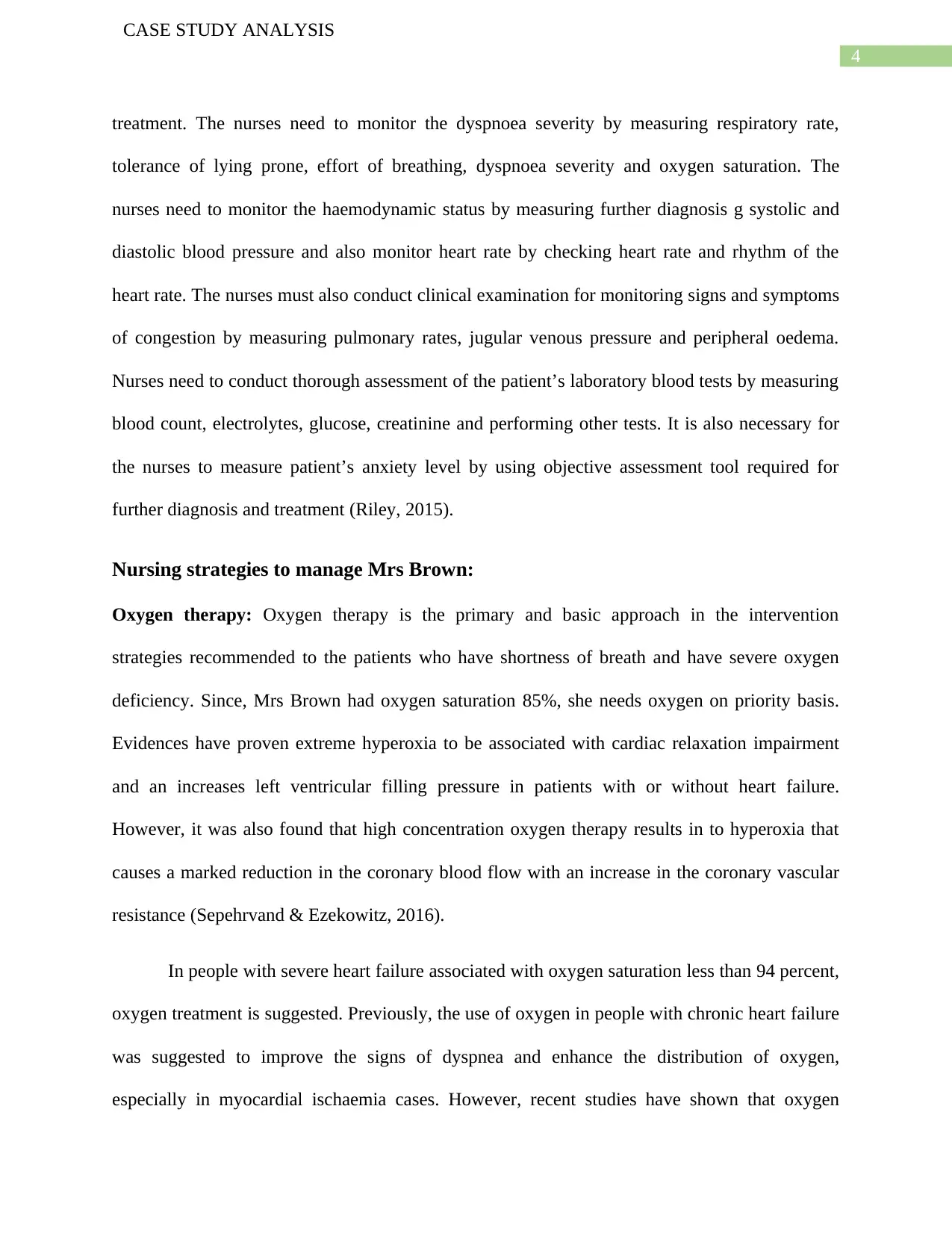
4
CASE STUDY ANALYSIS
treatment. The nurses need to monitor the dyspnoea severity by measuring respiratory rate,
tolerance of lying prone, effort of breathing, dyspnoea severity and oxygen saturation. The
nurses need to monitor the haemodynamic status by measuring further diagnosis g systolic and
diastolic blood pressure and also monitor heart rate by checking heart rate and rhythm of the
heart rate. The nurses must also conduct clinical examination for monitoring signs and symptoms
of congestion by measuring pulmonary rates, jugular venous pressure and peripheral oedema.
Nurses need to conduct thorough assessment of the patient’s laboratory blood tests by measuring
blood count, electrolytes, glucose, creatinine and performing other tests. It is also necessary for
the nurses to measure patient’s anxiety level by using objective assessment tool required for
further diagnosis and treatment (Riley, 2015).
Nursing strategies to manage Mrs Brown:
Oxygen therapy: Oxygen therapy is the primary and basic approach in the intervention
strategies recommended to the patients who have shortness of breath and have severe oxygen
deficiency. Since, Mrs Brown had oxygen saturation 85%, she needs oxygen on priority basis.
Evidences have proven extreme hyperoxia to be associated with cardiac relaxation impairment
and an increases left ventricular filling pressure in patients with or without heart failure.
However, it was also found that high concentration oxygen therapy results in to hyperoxia that
causes a marked reduction in the coronary blood flow with an increase in the coronary vascular
resistance (Sepehrvand & Ezekowitz, 2016).
In people with severe heart failure associated with oxygen saturation less than 94 percent,
oxygen treatment is suggested. Previously, the use of oxygen in people with chronic heart failure
was suggested to improve the signs of dyspnea and enhance the distribution of oxygen,
especially in myocardial ischaemia cases. However, recent studies have shown that oxygen
CASE STUDY ANALYSIS
treatment. The nurses need to monitor the dyspnoea severity by measuring respiratory rate,
tolerance of lying prone, effort of breathing, dyspnoea severity and oxygen saturation. The
nurses need to monitor the haemodynamic status by measuring further diagnosis g systolic and
diastolic blood pressure and also monitor heart rate by checking heart rate and rhythm of the
heart rate. The nurses must also conduct clinical examination for monitoring signs and symptoms
of congestion by measuring pulmonary rates, jugular venous pressure and peripheral oedema.
Nurses need to conduct thorough assessment of the patient’s laboratory blood tests by measuring
blood count, electrolytes, glucose, creatinine and performing other tests. It is also necessary for
the nurses to measure patient’s anxiety level by using objective assessment tool required for
further diagnosis and treatment (Riley, 2015).
Nursing strategies to manage Mrs Brown:
Oxygen therapy: Oxygen therapy is the primary and basic approach in the intervention
strategies recommended to the patients who have shortness of breath and have severe oxygen
deficiency. Since, Mrs Brown had oxygen saturation 85%, she needs oxygen on priority basis.
Evidences have proven extreme hyperoxia to be associated with cardiac relaxation impairment
and an increases left ventricular filling pressure in patients with or without heart failure.
However, it was also found that high concentration oxygen therapy results in to hyperoxia that
causes a marked reduction in the coronary blood flow with an increase in the coronary vascular
resistance (Sepehrvand & Ezekowitz, 2016).
In people with severe heart failure associated with oxygen saturation less than 94 percent,
oxygen treatment is suggested. Previously, the use of oxygen in people with chronic heart failure
was suggested to improve the signs of dyspnea and enhance the distribution of oxygen,
especially in myocardial ischaemia cases. However, recent studies have shown that oxygen
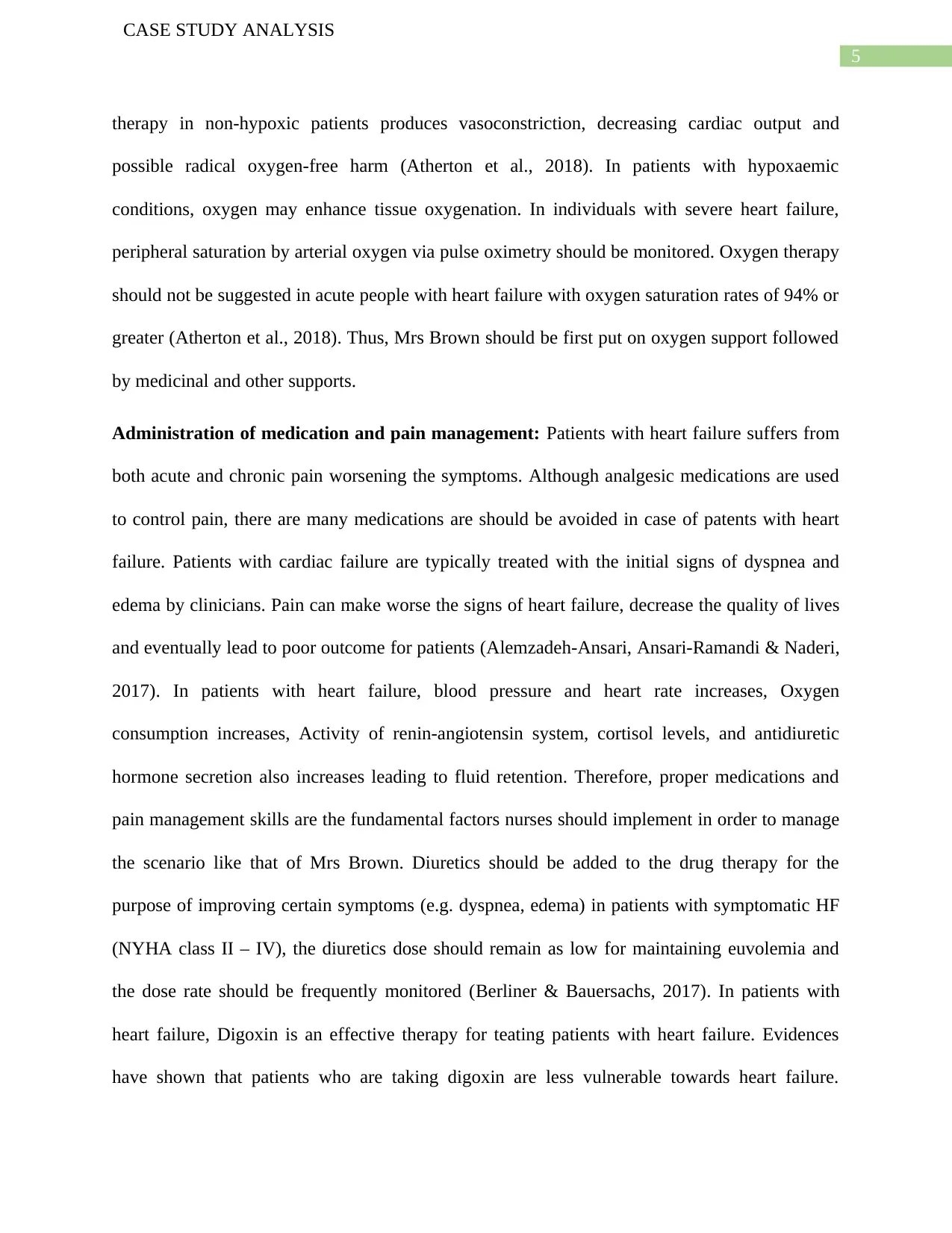
5
CASE STUDY ANALYSIS
therapy in non-hypoxic patients produces vasoconstriction, decreasing cardiac output and
possible radical oxygen-free harm (Atherton et al., 2018). In patients with hypoxaemic
conditions, oxygen may enhance tissue oxygenation. In individuals with severe heart failure,
peripheral saturation by arterial oxygen via pulse oximetry should be monitored. Oxygen therapy
should not be suggested in acute people with heart failure with oxygen saturation rates of 94% or
greater (Atherton et al., 2018). Thus, Mrs Brown should be first put on oxygen support followed
by medicinal and other supports.
Administration of medication and pain management: Patients with heart failure suffers from
both acute and chronic pain worsening the symptoms. Although analgesic medications are used
to control pain, there are many medications are should be avoided in case of patents with heart
failure. Patients with cardiac failure are typically treated with the initial signs of dyspnea and
edema by clinicians. Pain can make worse the signs of heart failure, decrease the quality of lives
and eventually lead to poor outcome for patients (Alemzadeh-Ansari, Ansari-Ramandi & Naderi,
2017). In patients with heart failure, blood pressure and heart rate increases, Oxygen
consumption increases, Activity of renin-angiotensin system, cortisol levels, and antidiuretic
hormone secretion also increases leading to fluid retention. Therefore, proper medications and
pain management skills are the fundamental factors nurses should implement in order to manage
the scenario like that of Mrs Brown. Diuretics should be added to the drug therapy for the
purpose of improving certain symptoms (e.g. dyspnea, edema) in patients with symptomatic HF
(NYHA class II – IV), the diuretics dose should remain as low for maintaining euvolemia and
the dose rate should be frequently monitored (Berliner & Bauersachs, 2017). In patients with
heart failure, Digoxin is an effective therapy for teating patients with heart failure. Evidences
have shown that patients who are taking digoxin are less vulnerable towards heart failure.
CASE STUDY ANALYSIS
therapy in non-hypoxic patients produces vasoconstriction, decreasing cardiac output and
possible radical oxygen-free harm (Atherton et al., 2018). In patients with hypoxaemic
conditions, oxygen may enhance tissue oxygenation. In individuals with severe heart failure,
peripheral saturation by arterial oxygen via pulse oximetry should be monitored. Oxygen therapy
should not be suggested in acute people with heart failure with oxygen saturation rates of 94% or
greater (Atherton et al., 2018). Thus, Mrs Brown should be first put on oxygen support followed
by medicinal and other supports.
Administration of medication and pain management: Patients with heart failure suffers from
both acute and chronic pain worsening the symptoms. Although analgesic medications are used
to control pain, there are many medications are should be avoided in case of patents with heart
failure. Patients with cardiac failure are typically treated with the initial signs of dyspnea and
edema by clinicians. Pain can make worse the signs of heart failure, decrease the quality of lives
and eventually lead to poor outcome for patients (Alemzadeh-Ansari, Ansari-Ramandi & Naderi,
2017). In patients with heart failure, blood pressure and heart rate increases, Oxygen
consumption increases, Activity of renin-angiotensin system, cortisol levels, and antidiuretic
hormone secretion also increases leading to fluid retention. Therefore, proper medications and
pain management skills are the fundamental factors nurses should implement in order to manage
the scenario like that of Mrs Brown. Diuretics should be added to the drug therapy for the
purpose of improving certain symptoms (e.g. dyspnea, edema) in patients with symptomatic HF
(NYHA class II – IV), the diuretics dose should remain as low for maintaining euvolemia and
the dose rate should be frequently monitored (Berliner & Bauersachs, 2017). In patients with
heart failure, Digoxin is an effective therapy for teating patients with heart failure. Evidences
have shown that patients who are taking digoxin are less vulnerable towards heart failure.
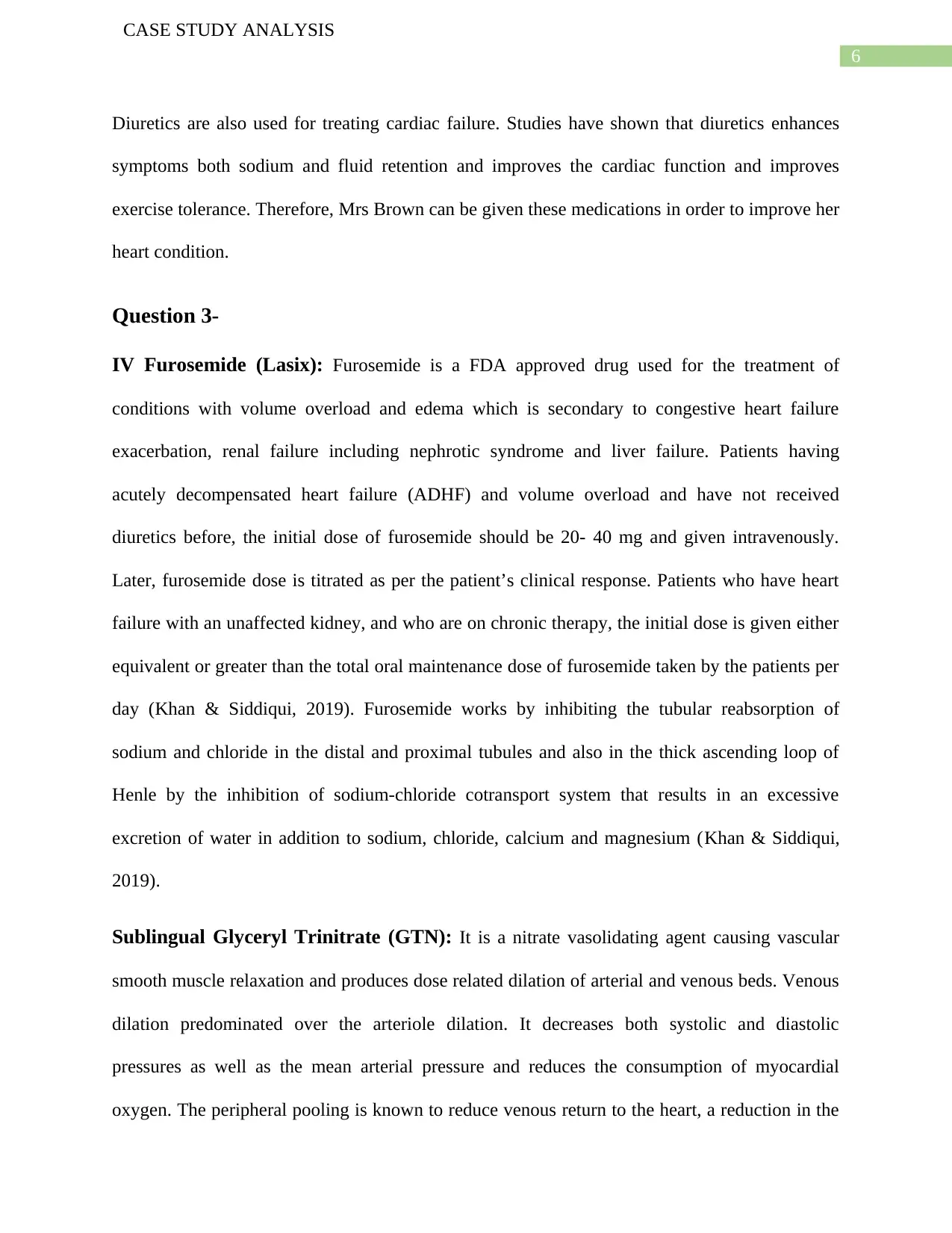
6
CASE STUDY ANALYSIS
Diuretics are also used for treating cardiac failure. Studies have shown that diuretics enhances
symptoms both sodium and fluid retention and improves the cardiac function and improves
exercise tolerance. Therefore, Mrs Brown can be given these medications in order to improve her
heart condition.
Question 3-
IV Furosemide (Lasix): Furosemide is a FDA approved drug used for the treatment of
conditions with volume overload and edema which is secondary to congestive heart failure
exacerbation, renal failure including nephrotic syndrome and liver failure. Patients having
acutely decompensated heart failure (ADHF) and volume overload and have not received
diuretics before, the initial dose of furosemide should be 20- 40 mg and given intravenously.
Later, furosemide dose is titrated as per the patient’s clinical response. Patients who have heart
failure with an unaffected kidney, and who are on chronic therapy, the initial dose is given either
equivalent or greater than the total oral maintenance dose of furosemide taken by the patients per
day (Khan & Siddiqui, 2019). Furosemide works by inhibiting the tubular reabsorption of
sodium and chloride in the distal and proximal tubules and also in the thick ascending loop of
Henle by the inhibition of sodium-chloride cotransport system that results in an excessive
excretion of water in addition to sodium, chloride, calcium and magnesium (Khan & Siddiqui,
2019).
Sublingual Glyceryl Trinitrate (GTN): It is a nitrate vasolidating agent causing vascular
smooth muscle relaxation and produces dose related dilation of arterial and venous beds. Venous
dilation predominated over the arteriole dilation. It decreases both systolic and diastolic
pressures as well as the mean arterial pressure and reduces the consumption of myocardial
oxygen. The peripheral pooling is known to reduce venous return to the heart, a reduction in the
CASE STUDY ANALYSIS
Diuretics are also used for treating cardiac failure. Studies have shown that diuretics enhances
symptoms both sodium and fluid retention and improves the cardiac function and improves
exercise tolerance. Therefore, Mrs Brown can be given these medications in order to improve her
heart condition.
Question 3-
IV Furosemide (Lasix): Furosemide is a FDA approved drug used for the treatment of
conditions with volume overload and edema which is secondary to congestive heart failure
exacerbation, renal failure including nephrotic syndrome and liver failure. Patients having
acutely decompensated heart failure (ADHF) and volume overload and have not received
diuretics before, the initial dose of furosemide should be 20- 40 mg and given intravenously.
Later, furosemide dose is titrated as per the patient’s clinical response. Patients who have heart
failure with an unaffected kidney, and who are on chronic therapy, the initial dose is given either
equivalent or greater than the total oral maintenance dose of furosemide taken by the patients per
day (Khan & Siddiqui, 2019). Furosemide works by inhibiting the tubular reabsorption of
sodium and chloride in the distal and proximal tubules and also in the thick ascending loop of
Henle by the inhibition of sodium-chloride cotransport system that results in an excessive
excretion of water in addition to sodium, chloride, calcium and magnesium (Khan & Siddiqui,
2019).
Sublingual Glyceryl Trinitrate (GTN): It is a nitrate vasolidating agent causing vascular
smooth muscle relaxation and produces dose related dilation of arterial and venous beds. Venous
dilation predominated over the arteriole dilation. It decreases both systolic and diastolic
pressures as well as the mean arterial pressure and reduces the consumption of myocardial
oxygen. The peripheral pooling is known to reduce venous return to the heart, a reduction in the
Paraphrase This Document
Need a fresh take? Get an instant paraphrase of this document with our AI Paraphraser
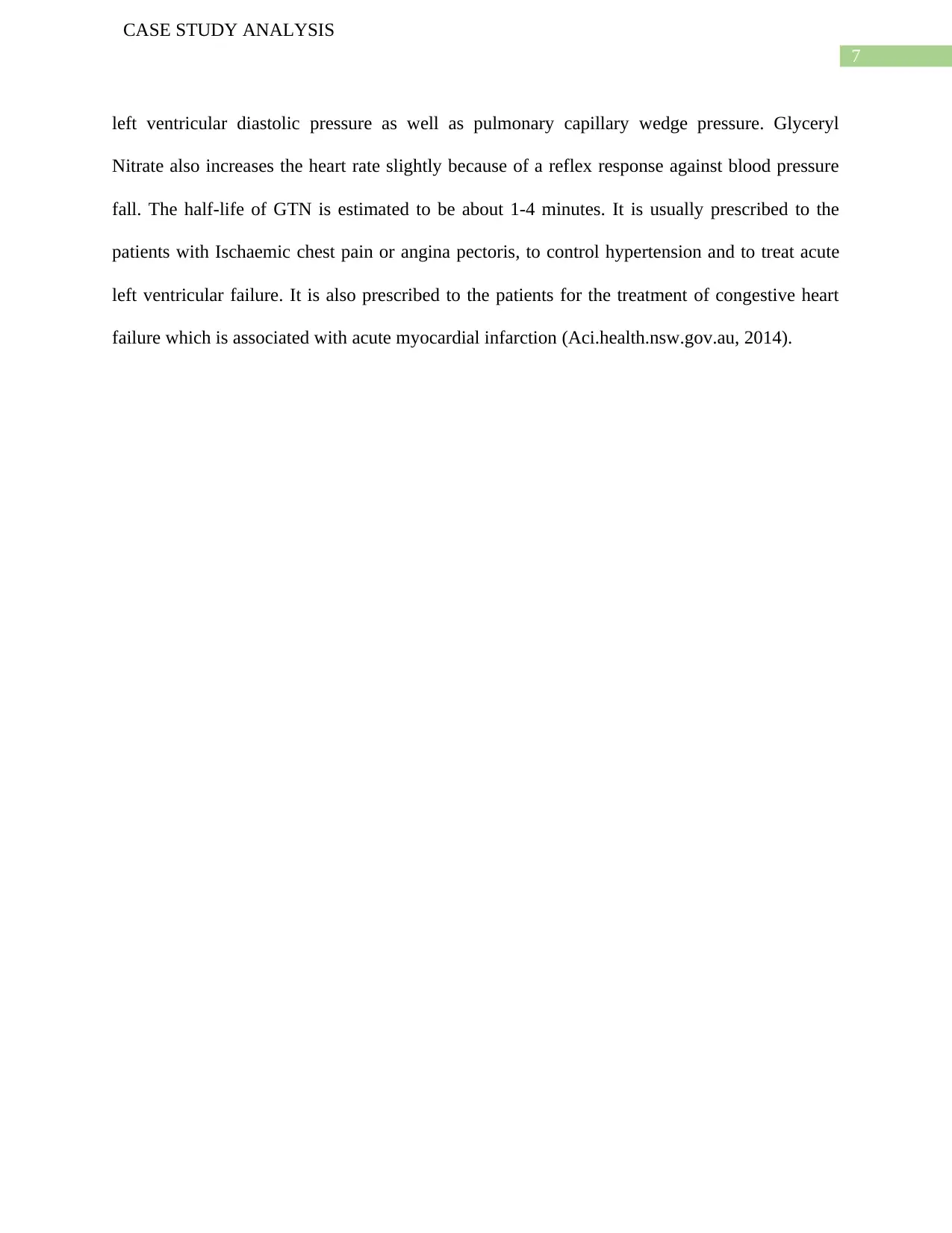
7
CASE STUDY ANALYSIS
left ventricular diastolic pressure as well as pulmonary capillary wedge pressure. Glyceryl
Nitrate also increases the heart rate slightly because of a reflex response against blood pressure
fall. The half-life of GTN is estimated to be about 1-4 minutes. It is usually prescribed to the
patients with Ischaemic chest pain or angina pectoris, to control hypertension and to treat acute
left ventricular failure. It is also prescribed to the patients for the treatment of congestive heart
failure which is associated with acute myocardial infarction (Aci.health.nsw.gov.au, 2014).
CASE STUDY ANALYSIS
left ventricular diastolic pressure as well as pulmonary capillary wedge pressure. Glyceryl
Nitrate also increases the heart rate slightly because of a reflex response against blood pressure
fall. The half-life of GTN is estimated to be about 1-4 minutes. It is usually prescribed to the
patients with Ischaemic chest pain or angina pectoris, to control hypertension and to treat acute
left ventricular failure. It is also prescribed to the patients for the treatment of congestive heart
failure which is associated with acute myocardial infarction (Aci.health.nsw.gov.au, 2014).
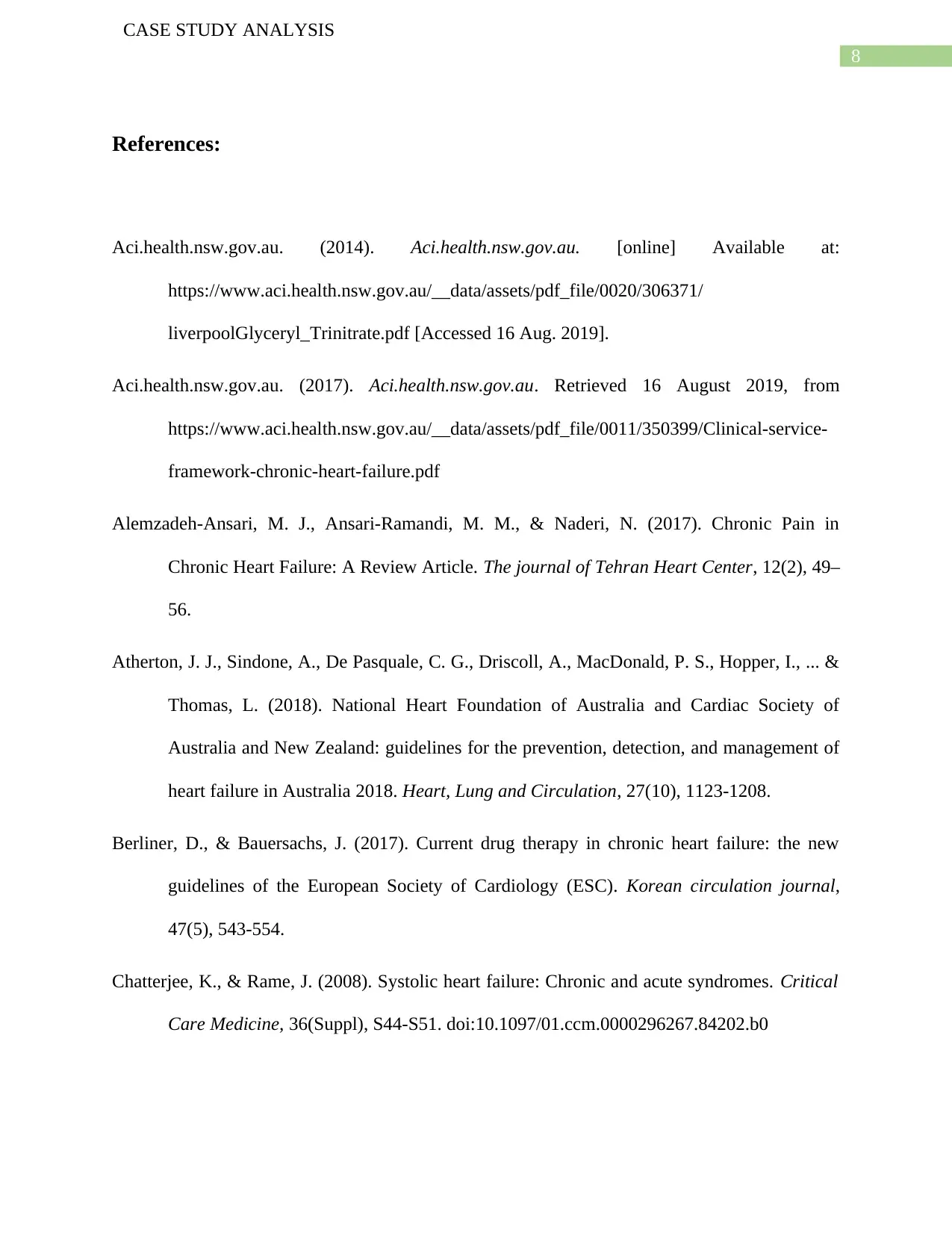
8
CASE STUDY ANALYSIS
References:
Aci.health.nsw.gov.au. (2014). Aci.health.nsw.gov.au. [online] Available at:
https://www.aci.health.nsw.gov.au/__data/assets/pdf_file/0020/306371/
liverpoolGlyceryl_Trinitrate.pdf [Accessed 16 Aug. 2019].
Aci.health.nsw.gov.au. (2017). Aci.health.nsw.gov.au. Retrieved 16 August 2019, from
https://www.aci.health.nsw.gov.au/__data/assets/pdf_file/0011/350399/Clinical-service-
framework-chronic-heart-failure.pdf
Alemzadeh-Ansari, M. J., Ansari-Ramandi, M. M., & Naderi, N. (2017). Chronic Pain in
Chronic Heart Failure: A Review Article. The journal of Tehran Heart Center, 12(2), 49–
56.
Atherton, J. J., Sindone, A., De Pasquale, C. G., Driscoll, A., MacDonald, P. S., Hopper, I., ... &
Thomas, L. (2018). National Heart Foundation of Australia and Cardiac Society of
Australia and New Zealand: guidelines for the prevention, detection, and management of
heart failure in Australia 2018. Heart, Lung and Circulation, 27(10), 1123-1208.
Berliner, D., & Bauersachs, J. (2017). Current drug therapy in chronic heart failure: the new
guidelines of the European Society of Cardiology (ESC). Korean circulation journal,
47(5), 543-554.
Chatterjee, K., & Rame, J. (2008). Systolic heart failure: Chronic and acute syndromes. Critical
Care Medicine, 36(Suppl), S44-S51. doi:10.1097/01.ccm.0000296267.84202.b0
CASE STUDY ANALYSIS
References:
Aci.health.nsw.gov.au. (2014). Aci.health.nsw.gov.au. [online] Available at:
https://www.aci.health.nsw.gov.au/__data/assets/pdf_file/0020/306371/
liverpoolGlyceryl_Trinitrate.pdf [Accessed 16 Aug. 2019].
Aci.health.nsw.gov.au. (2017). Aci.health.nsw.gov.au. Retrieved 16 August 2019, from
https://www.aci.health.nsw.gov.au/__data/assets/pdf_file/0011/350399/Clinical-service-
framework-chronic-heart-failure.pdf
Alemzadeh-Ansari, M. J., Ansari-Ramandi, M. M., & Naderi, N. (2017). Chronic Pain in
Chronic Heart Failure: A Review Article. The journal of Tehran Heart Center, 12(2), 49–
56.
Atherton, J. J., Sindone, A., De Pasquale, C. G., Driscoll, A., MacDonald, P. S., Hopper, I., ... &
Thomas, L. (2018). National Heart Foundation of Australia and Cardiac Society of
Australia and New Zealand: guidelines for the prevention, detection, and management of
heart failure in Australia 2018. Heart, Lung and Circulation, 27(10), 1123-1208.
Berliner, D., & Bauersachs, J. (2017). Current drug therapy in chronic heart failure: the new
guidelines of the European Society of Cardiology (ESC). Korean circulation journal,
47(5), 543-554.
Chatterjee, K., & Rame, J. (2008). Systolic heart failure: Chronic and acute syndromes. Critical
Care Medicine, 36(Suppl), S44-S51. doi:10.1097/01.ccm.0000296267.84202.b0
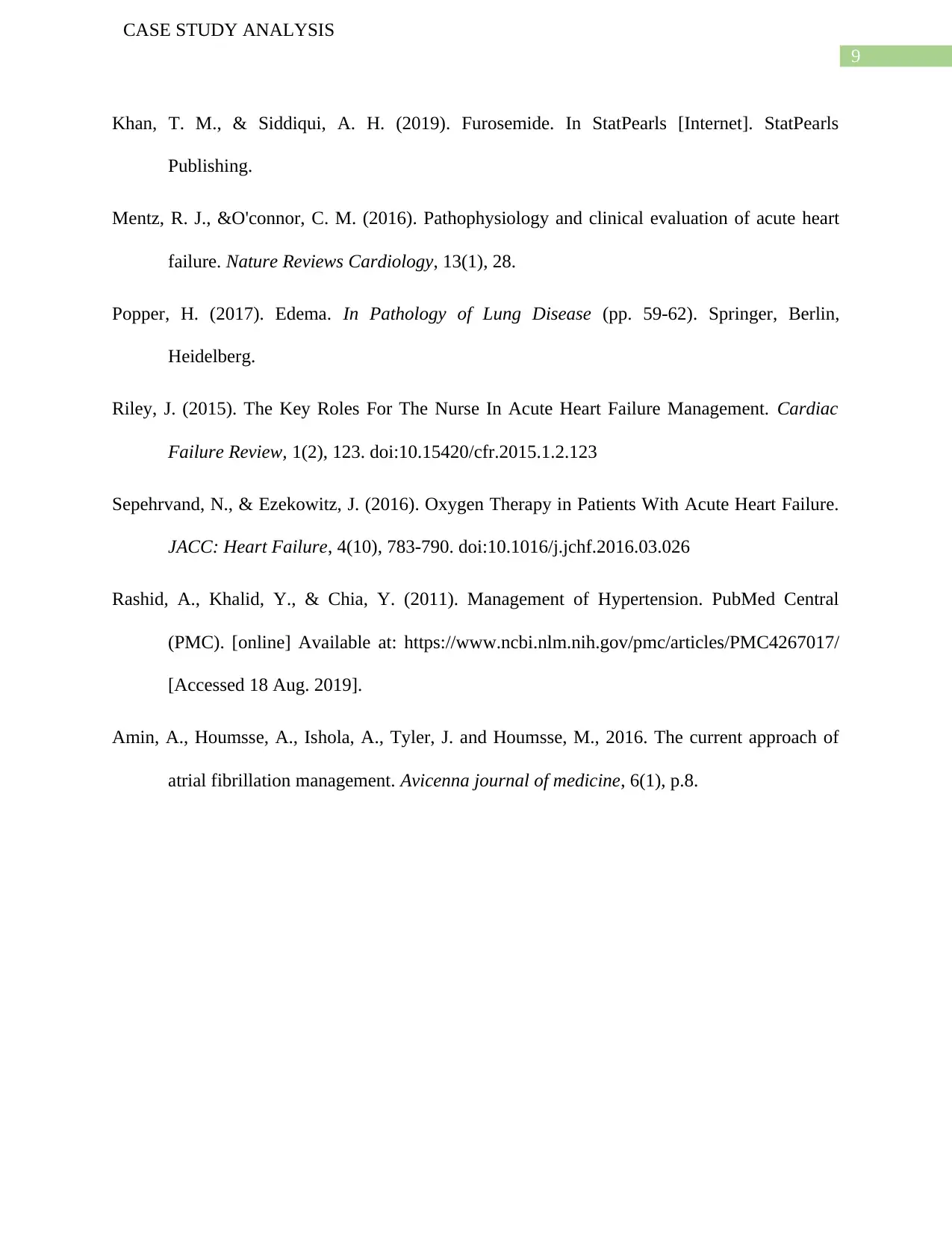
9
CASE STUDY ANALYSIS
Khan, T. M., & Siddiqui, A. H. (2019). Furosemide. In StatPearls [Internet]. StatPearls
Publishing.
Mentz, R. J., &O'connor, C. M. (2016). Pathophysiology and clinical evaluation of acute heart
failure. Nature Reviews Cardiology, 13(1), 28.
Popper, H. (2017). Edema. In Pathology of Lung Disease (pp. 59-62). Springer, Berlin,
Heidelberg.
Riley, J. (2015). The Key Roles For The Nurse In Acute Heart Failure Management. Cardiac
Failure Review, 1(2), 123. doi:10.15420/cfr.2015.1.2.123
Sepehrvand, N., & Ezekowitz, J. (2016). Oxygen Therapy in Patients With Acute Heart Failure.
JACC: Heart Failure, 4(10), 783-790. doi:10.1016/j.jchf.2016.03.026
Rashid, A., Khalid, Y., & Chia, Y. (2011). Management of Hypertension. PubMed Central
(PMC). [online] Available at: https://www.ncbi.nlm.nih.gov/pmc/articles/PMC4267017/
[Accessed 18 Aug. 2019].
Amin, A., Houmsse, A., Ishola, A., Tyler, J. and Houmsse, M., 2016. The current approach of
atrial fibrillation management. Avicenna journal of medicine, 6(1), p.8.
CASE STUDY ANALYSIS
Khan, T. M., & Siddiqui, A. H. (2019). Furosemide. In StatPearls [Internet]. StatPearls
Publishing.
Mentz, R. J., &O'connor, C. M. (2016). Pathophysiology and clinical evaluation of acute heart
failure. Nature Reviews Cardiology, 13(1), 28.
Popper, H. (2017). Edema. In Pathology of Lung Disease (pp. 59-62). Springer, Berlin,
Heidelberg.
Riley, J. (2015). The Key Roles For The Nurse In Acute Heart Failure Management. Cardiac
Failure Review, 1(2), 123. doi:10.15420/cfr.2015.1.2.123
Sepehrvand, N., & Ezekowitz, J. (2016). Oxygen Therapy in Patients With Acute Heart Failure.
JACC: Heart Failure, 4(10), 783-790. doi:10.1016/j.jchf.2016.03.026
Rashid, A., Khalid, Y., & Chia, Y. (2011). Management of Hypertension. PubMed Central
(PMC). [online] Available at: https://www.ncbi.nlm.nih.gov/pmc/articles/PMC4267017/
[Accessed 18 Aug. 2019].
Amin, A., Houmsse, A., Ishola, A., Tyler, J. and Houmsse, M., 2016. The current approach of
atrial fibrillation management. Avicenna journal of medicine, 6(1), p.8.
1 out of 10
Related Documents
Your All-in-One AI-Powered Toolkit for Academic Success.
+13062052269
info@desklib.com
Available 24*7 on WhatsApp / Email
![[object Object]](/_next/static/media/star-bottom.7253800d.svg)
Unlock your academic potential
© 2024 | Zucol Services PVT LTD | All rights reserved.





